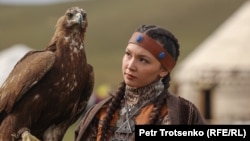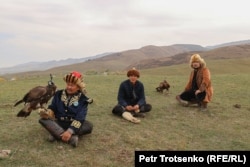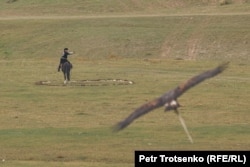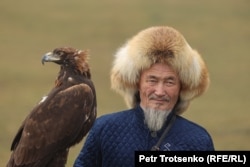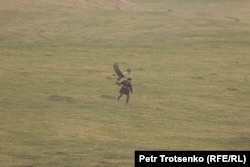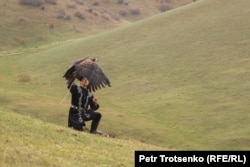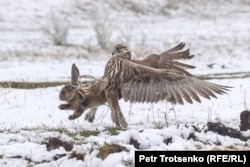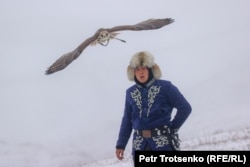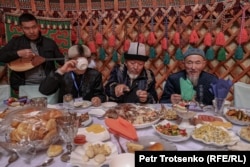Using raptors to hunt foxes, wolves, and other small mammals has long been a traditional form of hunting among Kazakhs, and it is still practiced today as eagle hunters, known as "Berkutchi," showcase their birds of prey in a competition held in the Almaty region.
Competitors from China and Mongolia also joined the competition in the village of Aqai Nusipbekov, where 70 eagles took flight, captivating the crowd of bird-watchers against the backdrop of snow-covered steppes.
The tournament, Salburyn 2023, was dedicated to Sarsenbek Dauletbakov, a bird-watcher who was born and raised in the village where the hunt was held this year. Dauletbakov was instrumental in keeping the tradition of eagle hunting alive.
The opening day of this year's three-day competition was shrouded in fog and mist. However, on the second day, snowfall blanketed the steppes in a white layer.
For the hunters and their birds, who traveled from far and wide, it was important to allow the birds to get a look at the new terrain in which they would be competing.
One such participant was out training his bird, who was enjoying the new surroundings so well that it soared above until weariness set in, and only then did it return to its waiting owner.
Birds Of Prey
An adult eagle is a formidable and large bird with wingspans of up to 2 meters. The length of its talons can extend to about 7 centimeters. Eagles are known for their impressive flying abilities, capable of reaching speeds exceeding 300 kilometers per hour.
Before the start of the competition, birders are warned that it is dangerous to get close to these birds of prey and that photos should always be taken from a distance. An eagle may pounce on a bystander when it is searching for food or gets excited.
The Training
The first step in the training process is to catch a young eagle, usually a golden eagle, in the wild. These eagles will develop a strong bond with their human trainers as they mature. The goal of the training is to condition the eagles to fly to the trainer's glove, hunt, and obey directions.
The Competition
The first stage of the competition assesses the birds' responsiveness to their hunters' commands. Positioned atop a nearby hill, an assistant releases the bird. The bird's challenge is to identify its master's call from a distance and return promptly to the hunter, who stands at the center of a stone circle. Successfully completing this task allows the bird to advance to the next stage of the competition.
Another part of the competition evaluates the eagle's hunting skills, particularly its ability to catch prey. A piece of fur or hide is attached to a string and swung around to mimic prey. The eagle is trained to dive, capture the "prey," and return to the hunter upon command. If it successfully executes this task, it proceeds to the finals of the tournament.
Hunting with golden eagles is an expensive pursuit. An eagle can cost several thousand dollars, depending on its age, size, and gender. Female eagles cost more, as they are larger and considered better hunters.
"Our hunters not only teach these skills but act as coaches," said Didar Bodes, one of the organizers of the tournament. "Of course, there are those who catch birds, go to parties, and compete," he added.
"In the future, we would like hunters to work at the airport, where they will train the eagles to drive away birds from the airfield. This practice is widespread in Europe. Why don't we introduce it?" Bodes said. "We have talked with foreign ornithologists, and we are now creating a program to introduce this skill to Kazakhstan."
The Finals
The final stage of the tournament is to evaluate how hunters train their eagles to capture live game. According to Didar Bodes, the winner must meet several requirements. First of all, he looks at the bird's speed, beauty, and special behavior while hunting. Also, the hunter is required to be dressed in traditional attire.
Though the handlers try to rescue the hares from getting killed, it is normally too late.
During the competition, several yurts were built for bird-watchers and spectators to warm up, drink hot tea, and enjoy a lunch of traditional Kazakh food.
"We slaughtered eight sheep and three horses for this competition," said Tursyn, an Akai Nusipbekov resident. He also organized the yurts and food for the tournament.
Three winners were announced during this year's competition, all hailing from Kazakhstan.
The locals are hoping that the tournament will return next year, bringing in more tourists and much-needed money while also honoring a long-standing tradition of the nomadic people who have lived on these steppes for millennia.




